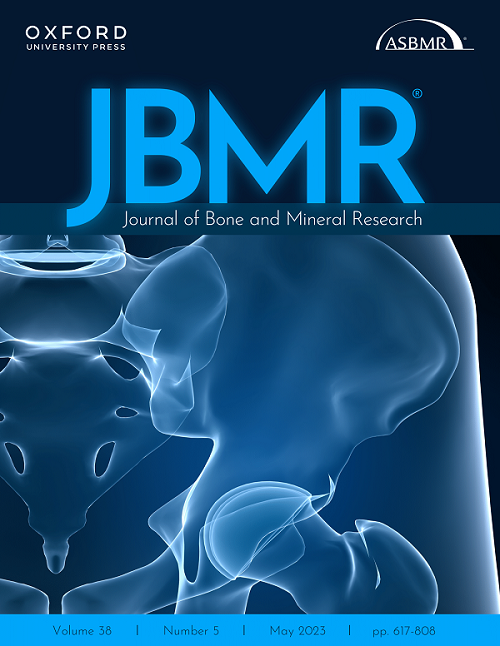Wenhao Qi, Zhendong Mei, Zhonghan Sun, Chenhao Lin, Jinran Lin, Jialin Li, John S. Ji, Yan Zheng
求助PDF
{"title":"Exposure to Multiple Air Pollutants and the Risk of Fractures: A Large Prospective Population-Based Study","authors":"Wenhao Qi, Zhendong Mei, Zhonghan Sun, Chenhao Lin, Jinran Lin, Jialin Li, John S. Ji, Yan Zheng","doi":"10.1002/jbmr.4872","DOIUrl":null,"url":null,"abstract":"<div>\n \n <p>Atmospheric chemistry studies suggest air pollution impedes ultraviolet B photons and thus reduces cutaneous vitamin D<sub>3</sub> synthesis. Biological evidence shows that inhaled pollutants disrupt circulating 25-hydroxyvitamin D (25[OH]D) metabolism and ultimately impact bone health. The hypothesis is that higher air pollution concentrations are associated with a higher risk of fractures, mediated by lower circulating 25(OH)D. The study included participants of the UK Biobank who were free of fracture history at enrollment (2006 to 2010) and analyzed their environmental exposure data (2007 to 2010). Air pollution measurements included the annual averages of air particulate matter (PM<sub>2.5</sub>, PM<sub>2.5–10</sub>, and PM<sub>10</sub>), nitrogen oxides (NO<sub>2</sub> and NO<sub>x</sub>), and a composite air pollution score. Multivariable Cox proportional hazard models were used to assess the associations of the individual pollutants and the score with fracture risks. Mediation analyses were conducted to assess the underlying role of serum 25(OH)D in such associations. Among 446,395 participants with a median of 8-year follow-up, 12,288 incident fractures were documented. Participants living in places with the highest quintile of air pollution score had a 15.3% increased risk of fractures (hazard ratio [95%CI]: 1.15[1.09,1.22]) compared to those in the lowest, and 5.49% of this association was mediated through serum 25(OH)D (<i>p</i><sub>mediation</sub> < 0.05). Pollutant-specific hazard of top-to-bottom quintiles was 16% for PM<sub>2.5</sub>, 4% for PM<sub>2.5–10</sub>, 5% for PM<sub>10</sub>, 20% for NO<sub>2</sub>, and 17% for NO<sub>x</sub>, with a 4% to 6% mediation effect of serum 25(OH)D concentrations. The associations of the air pollution score with fracture risks were weaker among female participants, those who drank less alcohol, and consumed more fresh fruit than their counterparts (<i>p</i><sub>interaction</sub> < 0.05). © 2023 American Society for Bone and Mineral Research (ASBMR).</p>\n </div>","PeriodicalId":185,"journal":{"name":"Journal of Bone and Mineral Research","volume":"38 11","pages":"1549-1559"},"PeriodicalIF":5.1000,"publicationDate":"2023-06-21","publicationTypes":"Journal Article","fieldsOfStudy":null,"isOpenAccess":false,"openAccessPdf":"","citationCount":"0","resultStr":null,"platform":"Semanticscholar","paperid":null,"PeriodicalName":"Journal of Bone and Mineral Research","FirstCategoryId":"3","ListUrlMain":"https://onlinelibrary.wiley.com/doi/10.1002/jbmr.4872","RegionNum":1,"RegionCategory":"医学","ArticlePicture":[],"TitleCN":null,"AbstractTextCN":null,"PMCID":null,"EPubDate":"","PubModel":"","JCR":"Q1","JCRName":"ENDOCRINOLOGY & METABOLISM","Score":null,"Total":0}
引用次数: 0
引用
批量引用
Abstract
Atmospheric chemistry studies suggest air pollution impedes ultraviolet B photons and thus reduces cutaneous vitamin D3 synthesis. Biological evidence shows that inhaled pollutants disrupt circulating 25-hydroxyvitamin D (25[OH]D) metabolism and ultimately impact bone health. The hypothesis is that higher air pollution concentrations are associated with a higher risk of fractures, mediated by lower circulating 25(OH)D. The study included participants of the UK Biobank who were free of fracture history at enrollment (2006 to 2010) and analyzed their environmental exposure data (2007 to 2010). Air pollution measurements included the annual averages of air particulate matter (PM2.5 , PM2.5–10 , and PM10 ), nitrogen oxides (NO2 and NOx ), and a composite air pollution score. Multivariable Cox proportional hazard models were used to assess the associations of the individual pollutants and the score with fracture risks. Mediation analyses were conducted to assess the underlying role of serum 25(OH)D in such associations. Among 446,395 participants with a median of 8-year follow-up, 12,288 incident fractures were documented. Participants living in places with the highest quintile of air pollution score had a 15.3% increased risk of fractures (hazard ratio [95%CI]: 1.15[1.09,1.22]) compared to those in the lowest, and 5.49% of this association was mediated through serum 25(OH)D (p mediation < 0.05). Pollutant-specific hazard of top-to-bottom quintiles was 16% for PM2.5 , 4% for PM2.5–10 , 5% for PM10 , 20% for NO2 , and 17% for NOx , with a 4% to 6% mediation effect of serum 25(OH)D concentrations. The associations of the air pollution score with fracture risks were weaker among female participants, those who drank less alcohol, and consumed more fresh fruit than their counterparts (p interaction < 0.05). © 2023 American Society for Bone and Mineral Research (ASBMR).
暴露于多种空气污染物和骨折风险:一项基于人群的大型前瞻性研究。
大气化学研究表明,空气污染会阻碍紫外线B光子,从而减少皮肤维生素D3的合成。生物学证据表明,吸入污染物会破坏循环中的25-羟基维生素D (25[OH]D)代谢,并最终影响骨骼健康。假设较高的空气污染浓度与较高的骨折风险有关,这是由较低的循环25(OH)D介导的。该研究纳入了英国生物银行的参与者,他们在入组时(2006年至2010年)没有骨折史,并分析了他们的环境暴露数据(2007年至2010年)。空气污染测量包括空气颗粒物(PM2.5、PM2.5-10和PM10)、氮氧化物(NO2和NOx)的年平均值,以及综合空气污染评分。使用多变量Cox比例风险模型来评估单个污染物和评分与骨折风险的关系。进行中介分析以评估血清25(OH)D在这些关联中的潜在作用。在446,395名参与者中,随访时间中位数为8年,记录了12,288例意外骨折。生活在空气污染评分最高五分位数的地区的参与者骨折风险比最低五分位数的参与者高15.3%(风险比[95%CI]: 1.15[1.09,1.22]),其中5.49%的关联是通过血清25(OH)D介导的(pm2.5为2.5,PM2.5-10为4%,PM10为5%,NO2为20%,NOx为17%),其中血清25(OH)D浓度的介导作用为4%至6%。空气污染得分与骨折风险之间的关联在女性参与者中较弱,这些参与者饮酒较少,并食用更多新鲜水果(相互作用)
本文章由计算机程序翻译,如有差异,请以英文原文为准。

 求助内容:
求助内容: 应助结果提醒方式:
应助结果提醒方式:


